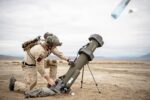Iran has unveiled a new containerized cruise missile system designated CM-300LA during a recent military parade. The system is capable of launching three land-attack cruise missiles in rapid succession from a concealed shipping container format. This development reflects Tehran’s ongoing investment in mobile anti-access/area denial (A2/AD) capabilities designed to complicate detection and preemption by adversaries.
CM-300LA Overview: A Containerized Land-Attack Cruise Missile System
The CM-300LA is a truck-mounted container-based launcher that houses three land-attack cruise missiles (LACMs), reportedly derived from or inspired by Iran’s existing Soumar or Meshkat missile families. The launcher mimics the form factor of a standard 20-foot ISO shipping container, enabling covert deployment on civilian or military logistics vehicles.
According to Iranian state media and imagery from the September 2025 unveiling in Tehran, the system can launch all three missiles within minutes. This rapid salvo capability enhances its utility for time-sensitive targeting and saturation attacks against fixed infrastructure such as airbases, ports, or command nodes.
The exact type of missile integrated into the CM-300LA remains unconfirmed. However, visual analysis suggests it may be an evolution of Iran’s long-range LACMs with an estimated range between 700–1,000 km. These likely use terrain-following guidance and are equipped with inertial navigation systems (INS) possibly augmented by satellite navigation (GNSS), although Iran’s reliance on indigenous alternatives due to sanctions may limit accuracy compared to Western systems.
Design Features and Operational Concept
The defining feature of the CM-300LA is its use of a standard shipping container as both camouflage and launch module. This approach mirrors concepts seen in other countries’ programs such as Russia’s Club-K or North Korea’s pseudo-container TELs for KN-series missiles. The modularity allows for flexible deployment on commercial trucks or railcars—enhancing survivability through mobility and deception.
- Launcher Configuration: Triple-cell vertical launch canister embedded inside ISO-standard container
- Mobility: Mounted on heavy-duty semi-trailer chassis pulled by commercial-grade tractor units
- Concealment: Visual similarity to civilian cargo containers enables covert staging in ports or industrial zones
- Crew Requirements: Likely minimal; fully automated fire-control system suspected based on limited operator interface shown
This configuration supports Iran’s doctrine of asymmetric warfare—leveraging low-cost but hard-to-detect systems to offset conventional inferiority against technologically superior adversaries such as the United States or Israel.
Cruise Missile Lineage: Soumar/Meshkat Derivatives?
The missiles launched from the CM-300LA appear externally similar to variants previously seen in Iran’s arsenal—most notably the Soumar (unveiled in 2015) and Hoveyzeh (2019). These are believed to be reverse-engineered derivatives of Soviet-era Kh-55 air-launched cruise missiles acquired from Ukraine post-Soviet collapse.
Key characteristics include:
- Range: Estimated between 700–1,000 km depending on variant
- Payload: Conventional high-explosive warhead (~450 kg); potential for submunitions or specialized payloads unconfirmed
- Guidance: Likely INS with terrain contour matching (TERCOM) and/or digital scene-matching area correlation (DSMAC)
- Propulsion: Small turbofan engine enabling low-altitude sustained flight at subsonic speeds (~Mach 0.7)
If confirmed as derivatives of Soumar-class weapons, these cruise missiles would offer Iran a precision-strike option across much of the Persian Gulf region—including U.S. bases in Kuwait, Bahrain, Qatar—as well as targets deep inside Saudi Arabia and Israel.
Tactical Implications for Regional A2/AD Posture
The introduction of mobile containerized LACM systems significantly enhances Iran’s ability to conduct preemptive or retaliatory strikes while evading early detection. Unlike traditional TELs that are easily recognized via satellite imagery due to their unique signatures, disguised launcher-containers can be hidden among civilian freight traffic until activated.
This complicates ISR efforts by adversaries seeking to neutralize Iranian strike assets before launch. Moreover, salvo capability allows multiple targets to be engaged simultaneously—a critical factor when attempting to saturate air defenses like Patriot PAC-3 or Israeli Iron Dome/David’s Sling systems that have finite interceptor inventories.
The CM-300LA also aligns with broader Iranian strategy emphasizing distributed lethality—spreading offensive capabilities across numerous small units rather than centralized platforms vulnerable to decapitation strikes.
Caveats and Limitations
Despite its strategic value on paper, several limitations must be considered regarding the operational effectiveness of the CM-300LA system:
- Lack of real-world combat validation: No known instances where Iranian LACMs have been used successfully against hardened targets under wartime conditions
- Susceptibility to electronic warfare: GNSS jamming/spoofing could degrade terminal accuracy if guidance is heavily reliant on satellite signals
- Siloed command structure: Iran’s decentralized control over IRGC vs regular army units may create C2 friction during crisis deployment
- Saturation vulnerability: While stealthy at rest, once fired these systems emit heat/plume signatures that could enable counterbattery tracking if ISR assets are nearby
A Growing Trend Toward Containerized Strike Systems Globally
The CM-300LA reflects a broader international trend toward modular strike platforms housed in nondescript containers—a concept pioneered by Russia’s Club-K but now explored by multiple nations including China and North Korea. These systems offer deniability during peacetime deployments while preserving rapid activation potential during conflict escalation phases.
NATO planners have long warned about “missiles-in-a-box” scenarios wherein adversaries deploy long-range precision fires from commercial-looking vehicles parked near sensitive areas like ports or airfields without triggering immediate alarm. The Iranian variant adds urgency given Tehran’s demonstrated willingness to use proxy forces and hybrid tactics across Lebanon (Hezbollah), Iraq (PMF), Syria (IRGC Quds Force), and Yemen (Houthis).









